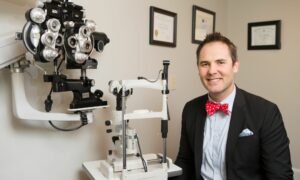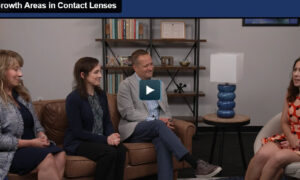Use of Trial CLs for Frames Selections = More CL Fits
By Leslie Gallagher, OD, FAAO
Would you like to add 100 new contact lens patients to your practice per year, above the number you’re already adding? How about making those 100 patients the best patients of them all: those who wear both contact lenses and spectacles?
It’s easy to do. In fact, you can do so with EASE, which is the acronym for “Enhancing the approach to selecting eyewear [EASE],” a 2009 study on the effect of applying contact lenses prior to spectacle dispensing.
The EASE study involved 91 patients with no previous contact lens experience. One-third of participants decided to become contact lens wearers on the basis of having been trial fit with a contact lens to assist them in the selection of spectacle frames.
A win-win-win situation
The experience in my practice is similar: More than one-third of patients who use trial lenses to try on spectacle frames schedule a follow-up contact lens evaluation.
Those that say, “No thanks,” to becoming regular contact lens wearers are nonetheless grateful for the exceptional service. At the same time, the temporary contact lenses help patients to better select frames, which results in fewer frame returns or redos for our practice. It’s truly a win-win-win situation.
In my practice, we don’t offer all patients temporary contact lenses to assist them in spectacle dispensing. While we do to all who come in with broken frames and no backup eyewear, we don’t offer them to -1.50D myopes; they can see well enough to select a frame they’ll be happy with.
As a -5.00D myope, however, I know from my own experience that patients can select frames at dispensing that they’ll later regret when they can clearly see. I keep a pair of ruby red Ralph Lauren frames that I bought—and never wore—before I entered optometry school to remind me of the hazards of selecting frames with uncorrected vision.
Implementation Points
To offer temporary contact lenses with EASE:
• Train staff how to vertex the spectacle power into a contact lens prescription, and add +1.00D for patients over age 50 so that their intermediate vision is optimized to view themselves in a mirror.
• Train optical dispensing staff how to insert contact lenses.
• Designate a daily wear lens for temporary fitting so to maximize the ease of insertion and patient comfort.
• Train staff to explain to patients that the temporary lenses may or may not be what their actual contact lens Rx would be, for which a follow-up contact lens examination would be required.
For those patients who may be contact lens dropouts, the temporary contacts often result in their expression that the lenses are so much more comfortable than what they remember.
In my practice, we used to take Polaroid photos of patients to show them how they looked in a frame to help them make a decision. There are software systems with a digital camera that serve the same purpose, enabling patients to see themselves in frames during dispensing.
With the EASE method, doctors don’t have to buy anything else. Best of all, it’s a moment in time that impresses patients with your extra level of service. Whether patients become part-time contact lenses wearers or not, this provides a win-win situation.
Leslie Gallagher, OD, FAAO, practices at Lifetime Eye Care (www.visionsource-holton.com) in Holton, Kansas.
Findings from the EASE Study
The EASE study* was devised to examine the impact of contact lens application in non-contact lens wearers prior to spectacle dispensing.
Method
Some 91 patients with no previous contact lens experience were split into two groups. One was offered contact lenses before spectacle dispensing. The other proceeded to spectacle dispensing without being offered contact lenses.
Results
Some 88 percent of the group offered contact lenses agreed to try them; 98 percent of them were successfully fit. These patients reported “a superior subjective spectacle dispensing experience and spent 32 percent more on their spectacles than the other group. Three months after dispensing, 33 percent of the patients who had been fit with contact lenses had purchased contact lenses, compared with 13 percent of the other group.
Conclusions
Contact lenses assisted in seeing frame detail and suitability for wear. The study’s authors conclude: “We recommend that practitioners consider offering contact lenses to all suitable patients who are proceeding to spectacle dispensing to optimize the dispensing process and to provide an opportunity to try contact lenses.”
*Atkins NP, et al. Enhancing the approach to selecting eyewear (EASE): A multi-centre, practice-based study into the effect of applying contact lenses prior to spectacle dispensing. Contact Lens & Anterior Eye (2009), doi:10.1016.
To Implement to EASE Study…
CIBA VISION’s Academy for Eyecare Excellence recommends:
Use a script
“We can put some lenses on to help you chose your frame. How do you feel about that?”
Use positive question to reassure
“How did you feel choosing your frames. How did the lenses help you?”
Use selective language
Use “on” instead of “in your eye;” use “application” instead of “insertion;” and use “lens” instead of “contact lens.”
Using Trial Contact Lenses for Frames Selection
By Steven I. Bennett, OD, FAAO




























